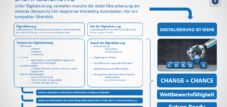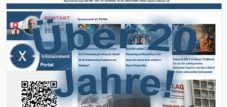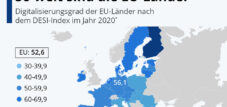Errors in digitalization | From overzealousness to overwhelm: The fine line of digitalization and how often it is ignored
Language selection 📢
Published on: June 25, 2024 / update from: June 28, 2024 - Author: Konrad Wolfenstein

From over -the -tongue to overwhelming: the narrow line of digitization and how often it is disregarded - picture: xpert.digital
🌐 The balance between digitization fever and overwhelming: challenges and strategies
🚀 Between progress and overload: How companies can master digitization
As is well known, digitization is an ongoing process, dominates our modern world and penetrates all areas of life: from communication to industry to administration. The advantages of this technological progress are undeniable. Highly developed analysis tools, automation and networking have made companies more efficient and opened consumers new opportunities. But this development also carries challenges and risks that are often overlooked or underestimated. One of them is the balance between overzealous progress and the associated overwhelming.
🚀 The rise of digitization
With the introduction of the Internet in the late 20th century, a revolution began to fundamentally changed the way we live and work. Information was now available anytime and anywhere, and globalization picked up speed. Companies were able to act worldwide, exchange information and goods in a matter of seconds and thus open up new markets. Methods such as "Just-in-Time" production and data-driven business strategies became the norm.
In the past two decades, this change has accelerated through the introduction of mobile technologies, social networks and artificial intelligence. They enabled even deeper networking and automation, but also an exponential increase in data that wanted to be managed and analyzed.
💡 the temptation of the overzeal
It is easy to be carried away by the apparently unlimited possibilities of digitization. Companies invest in highly complex systems for data analysis or start extensive digitization projects, often without a clear strategy or an understanding of the underlying processes. The pressure to keep up with the competition or even to be ahead often leads to projects being tackled.
However, this overzeal can quickly lead to a trap. Without well -founded knowledge and well thought -out planning, such projects can stall or even fail. Missing training courses, lack of adaptations to existing systems and insufficient consideration of the needs and structures of the company are just a few of the risks.
🚧 overwhelming as an inevitable sequence
It is a narrow line between the pursuit of innovation and the overwhelming due to too quick changes. The introduction of new technologies often also means that existing processes and structures have to be adapted or even completely converted. This can be a significant burden for employees who have to get used to new ways of working and tools in a very short time.
The flood of data associated with digital systems can be overwhelming. Without the right tools and skills, data analysis can quickly become an insurmountable challenge. Data not only have to be collected, but also sensibly evaluated in order to actually offer added value. If this does not succeed, this can lead to frustration and inefficient work processes.
🛠️ Strategies to avoid overwhelming
In order to keep the balance between digitization and overwhelming, a clear and structured approach is essential. It is about understanding digitization as an ongoing process and not as a unique project. The following aspects are particularly important:
1. Gradual implementation
A gradual introduction of new technologies can help reduce the burden for everyone involved. Pilot projects and test phases can identify and resolve initial problems before a complete rollout is carried out. In this way, companies can make necessary adjustments without disturbing the entire company.
2. Education and further education of the employees
The training of employees is crucial for the success of any digitization measures. Only if the workforce is familiar with the new technologies and their application can they be used effectively. This includes not only technical training, but also training on changing work processes and methods.
3. Management of change processes
Well thought -out changing management can help to reduce resistance and fears in the company. With clear communication and the integration of all stakeholders in the change process, acceptance is promoted and ambiguities can be removed at an early stage.
4. Develop data strategy
A clear data strategy is central to generate real added value from the large number of available data. This includes measures for data collection, storage, evaluation and security. This is the only way to ensure that data is not only collected, but also useful.
5. Technological support
The use of user -friendly technologies that can be seamlessly integrated into existing systems can make it easier to change. Cloud solutions, scalable software and intuitive user interfaces help to ensure that employees can work quickly and efficiently with the new tools.
🔄 bring people and technology into balance
A often overlooked aspect of digitization is the human component. Technology should always be seen as support for humans and not as a replacement. The focus must be on how technologies can make work easier and enable improvements without ignoring human skills and skills.
👥 The role of managers
Managers play a crucial role in the successful digitization of a company. You are responsible for defining the vision and paving the way there. This not only requires technical knowledge, but above all also leadership and the ability to manage changes. Transparent communication and the presentation of the digital transformation are essential.
Managers must also be able to set priorities and keep an overview. There are often a variety of possible projects and technologies that could theoretically be implemented. A careful selection and prioritization of the projects that bring the greatest benefit for the company is crucial.
🌟 insight and change
The narrow line between over -zealous and overwhelming in digitization is too often disregarded. The temptation to digitize as much as possible as possible is great. But to actually be successful, more is needed: a well thought -out strategy, a gradual implementation and, above all, the consideration of human factors. This is the only way to lead digitization to sustainable success and exploit full potential.
In the end, the art is to promote digital transformation at a pace that enables innovation without exceeding the company and its employees. This is the key to generate sustainable success from the hype about digitization.
📣 Similar topics
- 📣 Digitization in balance: How companies can avoid excessive demands
- 🤖 temptation and trap: How overriding digitization projects endangered
- 💼 Management competence as a key to successful digitization
- 📊 Data strategy as the basic pillar of successful digitization
- 🚀 Digital transformation: From quick change to sustainable innovation
- 🧠 Employee support: Continuing education as a success factor of digitization
- 🔍 Master data analysis: Tools and strategies for increasing efficiency
- 🔄 Man and technology: The right balance for digital success
- 🛠️ Gradually digitization: How to prevent pilot projects overload
- 💡 leadership and change: the role of managers in the digital era
#️⃣ hashtags: #digitization #overwhelming #change management #data strategy #leadership competence
Our recommendation: 🌍 Limitless reach 🔗 Networked 🌐 Multilingual 💪 Strong sales: 💡 Authentic with strategy 🚀 Innovation meets 🧠 Intuition
At a time when a company's digital presence determines its success, the challenge is how to make this presence authentic, individual and far-reaching. Xpert.Digital offers an innovative solution that positions itself as an intersection between an industry hub, a blog and a brand ambassador. It combines the advantages of communication and sales channels in a single platform and enables publication in 18 different languages. The cooperation with partner portals and the possibility of publishing articles on Google News and a press distribution list with around 8,000 journalists and readers maximize the reach and visibility of the content. This represents an essential factor in external sales & marketing (SMarketing).
More about it here:
📌 Other suitable topics
🌐🔍 Triosmarket ✅ is an innovative marketing strategy for online, digital and meta -verse marketing or symbols
Triosmarket is an innovative marketing strategy consisting of three main components, each using its own approaches and methods to achieve comprehensive and impactful market coverage.
More about it here:
We are there for you - advice - planning - implementation - project management
☑️ SME support in strategy, consulting, planning and implementation
☑️ Creation or realignment of the digital strategy and digitalization
☑️ Expansion and optimization of international sales processes
☑️ Global & Digital B2B trading platforms
☑️ Pioneer Business Development
I would be happy to serve as your personal advisor.
You can contact me by filling out the contact form below or simply call me on +49 89 89 674 804 (Munich) .
I'm looking forward to our joint project.
Xpert.Digital - Konrad Wolfenstein
Xpert.Digital is a hub for industry with a focus on digitalization, mechanical engineering, logistics/intralogistics and photovoltaics.
With our 360° business development solution, we support well-known companies from new business to after sales.
Market intelligence, smarketing, marketing automation, content development, PR, mail campaigns, personalized social media and lead nurturing are part of our digital tools.
You can find out more at: www.xpert.digital - www.xpert.solar - www.xpert.plus































